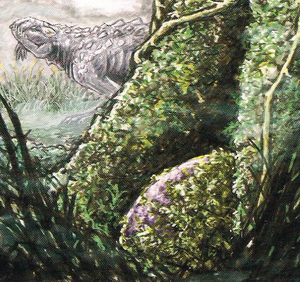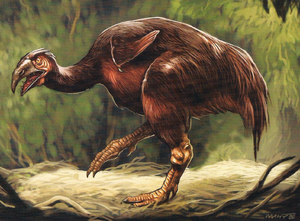|
Noctupervagus
| |
|
Name:
|
Noctupervagus pinguis
|
|
Abilities and Weapons:
|
Beak, Claws
|
|
Occupation:
|
Foraging macropredator
|
|
Home:
|
Skull Island
|
|
First Appearance:
|
"The World of Kong: A Natural History of Skull Island" (from 2005)
|
|
Diet:
|
Insectivore
|
|
Size:
|
Height: 3 meters
Weight Estimated: 300 kilograms |
|
Status:
|
Unknown. Presumably rescued by expeditions.
|
The Noctupervagus pinguis (filthy rich wandering through night) is a large, flightless, nocturnal novaeratite from the jungles of Skull Island. It measures 5-6 feet high at the hip and is 9.8 feet tall in total (3 meters).
Facts[]
The nocturnal Noctupervagus is a sharp-eyed forager amid the leaf litter of the jungle floor. With a powerful kick and - unlike the majority of birds - a saw-toothed beak, the bird is quite capable of defending itself from smaller predators and more than a match for the venomous centipedes, such as Megapede horridus, that it feeds on exclusively. Despite its size, the bird is able to delicately hold and dismember the centipedes with its foot and beak, removing the venomous mouthparts with a surgeon’s dexterity.

Noctupervagus eggs.
To hide them from harm, Noctupervagus eggs are dark and covered in a rich membranous coating, ideal for the growth of small spores and mosses. Shortly after being laid, the eggs become covered in small plants and fungi, camouflaging them from predators like Dinocanisaurus while their mother feeds in the jungle nearby. The tradeoff for the protection is that the fungus and plant growth can cause difficulty for the young trying to hatch. Parental assistance is essential to a successful hatching.
Trivia[]
- Its name roughly translates from latin as "filthy rich wandering through night". This may indicate that Noctupervagus is a nocturnal aviforme that hunts insects in the night with a extremely large appetite as pinguis also means "fat" in latin.
- Like all animals from Skull Island. It is unknown what they faced during the sinking of the island. Given the multiple expeditions, there may be a chance that a few surviving populations was saved off-land to a more stable enclosure.

